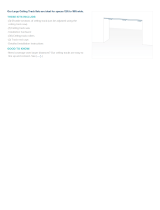Page is loading ...

Why Choose Dietrich Steel Studs
Over Wood Studs?
Steel studs won’t warp, shrink, split or twist. So your walls
are straighter, stronger, won’t develop nail pops or cracks
from shifting or settling over time. Unlike wood, Dietrich
Steel Studs are noncombustible and won’t harbor insects
or vermin. Dietrich Steel Studs also are made with pre-
punched holes for running plumbing and electrical wiring,
saving you time, money and effort. Plus, Dietrich nonload-
bearing studs are lightweight and can be easily removed,
altered and relocated.
Planning, Purchasing and Installation Guide for
Do-It-Yourself Wall Partitions
Basements • Family Rooms • Closets • Home Offices
Easy Installation
Pre-Punched For Wiring
Cost Competitive
Fireproof Termite Proof
Straighter Walls
Won’t Mold or Rot
Easy Installation
Pre-Punched For Wiring
Cost Competitive
Fireproof Termite Proof
Straighter Walls
Won’t Mold or Rot
Plan Your Project
1. Measuring: Using a tape measure, determine the
dimensions of the existing space as well as the lengths
of your new walls. It is a good idea to plot those dimen-
sions on grid paper (1square=1foot) so that you have a
top view of the project. Mark the wall dimensions on
your drawing.
2. Stud Spacing: Space the studs either 12”, 16” or 24”
on center. Note allowable wall height table below.
3. Number of Studs: Based on spacing requirements,
divide the wall length by 1 (12” o.c.), 1.3 (16” o.c.) or 2
(24” o.c.) to figure the number of studs needed. Add
one more stud for each corner.
4. Number of Track Sections: Multiply the total lineal feet
of wall by 2 to figure the amount of track needed for
floor and ceiling runners. Track is sold in 10’ lengths and
may need to be cut per wall.
Allowable Wall Heights
(L/240 deflection, 5 PSF)
Size Stud Spacing 12” 16” 24”
(in.) Code Gage (ft.-in.)
1-5/8 STN 25 7-10 7-1 6-2
2-1/2 STN 25 10-10 9-10 8-6
3-5/8 STN 25 14-4 13-0 11-5
NOTES: 1. Listed limiting heights are based on moment with a 1/3 stress increase,
shear, and deflection computed with lxeff. 2. Deflection calculations for limiting
heights are based on Procedure 1 of UBC 27-9. 3. Limiting heights can be used
vertically or horizontally as long as both stud flanges are fully braced by sheathing
material. 4. Drywall studs not intended for exterior or load bearing applications.
Basic Dietrich Framing Detail
Typical Interior Nonload-Bearing Wall
Material Check List
Description Where and what to use Qty. to
buy
Track Secure to ceiling and floor to hold
studs in place
Stud Twist into track at 12”, 16” or 24”
intervals and fasten
#7 x Pan Head Type “S” framing screws
7/16” Attach steel studs to steel track
3/16” x Masonry screws or powder-
1-1/4” actuated fasteners
Attach steel track to concrete floor
at 12” to 16” intervals
#6 x Bugle Head Type “S” drywall screws
1-1/4” Attach drywall to steel framing, and
track to wood floor and ceiling joists
Plastic grommets snap into pre-
punched holes to protect wiring
and plumbing
#7 x Trim Head Type “S” trim screws
1-5/8” Attach wood trim to steel framing
Special Orders Available
Including special sizes, lengths, gages or
other metal framing products
Framing Tools
• Reversible Drill or Screwgun – for installing or removing fas-
teners. Should have clutch to stop over penetration of fastener.
• Tin Snips – for trimming studs/track.
• Plumb Line – for aligning floor track with ceiling track.
• Measuring Tape – for measuring lengths and distances
• Framing Square – for square-cutting studs and track
• Level – for checking vertical/horizontal alignment
• C-Clamps or Open-Frame Locking Pliers – for holding unat-
tached studs/track securely when fastening with screwgun.
Safety Warning!
Eye protection is required to safeguard against metal pieces
and particles produced while cutting or screwing metal com-
ponents.
Safety goggles or glasses are recommended.
Leather-palm Gloves are recommended to protect against
sharp edges or burrs.
Drywall Tools
• Square
• Utility Knife Drywall Saw
• Rasp
• Joint Compound
• Paper Joint Tape
• Joint Knives
Top Runner (Track)
Metal Wall Stud
Wall Height
Plastic Grommet
Bottom Runner (Track)

1. Cut studs/runners
to required lengths as you
install using aviator snips or
circular saw with abrasive,
metal-cutting blade.
2. Attach ceiling runner.
Use drywall screws to attach to
joists. For parallel joists, bridge two
joists with C-runners spaced 24”
o.c. or less and install ceiling runner
across bridges. Use expandable
fasteners in the field of an existing
ceiling. Space fasteners 12”-16” on
center (2” from ends of runner).
3. Plum
to position floor runner
directly below ceiling runner.
4. Attach floor runner.
Use powder-actuated fasteners for
concrete floor. Use drywall screws for
wood subfloor. Same fastener spac-
ing as ceiling runner. Then mark stud
locations 16” or 24” o.c. top and
bottom starting from the same end.
5. Insert stud
at slight angle into runners–
then twist into place. Be sure
all stud legs are pointed the
same way for easier drywall
attachment and punchouts are
oriented the same way for
easy plumbing or electrical
installation.
6. Screw-attach stud to ceiling
runner and floor runner with 7/16”
pan or wafer-head screws. Hold
stud flange to runner for easier
screw attachment. Attachment of
drywall will hold studs in alignment.
7. Cut tabs approximately 4”
long for attaching door header
and stud bracing. Tabs may be
bent either up or down.
9. Attach C-Runner
bracing across studs to sup-
port cabinet attachment.
C-Runner must be notched to
fit between studs.
10. Insert grommets
or pieces of pipe insulation into
prepunched holes whenever you
pass through wiring and/or
plumbing. Your framing is now
complete and ready for installing
the drywall.
11. Screw-attach drywall
to framing using drywall screws per
manufacturers recommendations.
Board should be attached
advancing toward the open end
of the studs.
12. Install corner beads
and trim with screws or staples.
13. Tape and finish.
500 Grant Street, Suite 2226
Pittsburgh, PA 15219
(412) 281-2805 • (412) 281-2965 (fax)
dietrichmetalframing.com
The place to stop ... before the building starts.
Metal Framing
Installation Instructions
For Nonload-Bearing Interior Walls
8. Double studs back to back
to support header and door jambs.
Helpful Hints
• Most trim can be adhesively attached and may require
temporary screws while adhesive sets. If mechanical
attachment is required, consider inserting sections of wood
2x4 inside runners for nailing.
• Door frames can be attached directly to steel framing,
but many installers prefer wood 2x4 framing around the
rough opening.
• If framing is used to support insulation blankets, the
insulation will have to be ordered to the full 16” or 24”
width dimension.
• Hanging pictures or artwork can be handled easily with
standard hanging attachments except drywall screws are
recommended where studs are located.
• Extremely heavy shelving and other heavy objects that
project from the wall should be anticipated. Cross bracing
with C-Runners as recommended for cabinet attachment is
suggested for this purpose as well.
Copyright 2003 Dietrich Metal Framing Printed in U.S.A.
LIMITATIONS: 25-gauge Steel Studs are designed for use in nonload-bearing construc-
tion only. Check local building codes before beginning construction
NOTICE: We shall not be liable for incidental and consequential damages, directly or
indirectly sustained, nor for any loss caused by application of these goods not in accor-
dance with current printed instructions or for other than the intended use. Our liability is
expressly limited to replacement of defective goods. Any claim shall be deemed waived
unless made in writing to us within thirty (30) days from date it was or reasonably should
have been discovered.
Door &
Window
Header
Wall
Intersection
Soffit
Bracing for
cabinet &
fixture
attachment
(1) Screw Each Side
Short 6’ Section of Stud
Screw Attached to Stud
& Runner Track
Screw Attach Studs Together w/Screws Every 12’ O.C.
/









